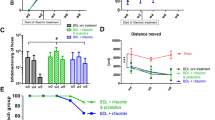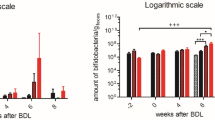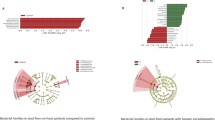Abstract
The pathogenesis of hepatic encephalopathy(HE) is unclear. However gut flora changes, inflammation and neuro-glial injury have been implicated. The aim was to evaluate factors that were associated with HE recurrence after lactulose withdrawal by analyzing the clinical phenotype, stool microbiome and systemic metabolome longitudinally. HE patients on a standard diet who were adherent on lactulose underwent characterization of their phenotype [cognition, inflammatory cytokines, in-vivo brain MR spectroscopy(MRS)], gut microbiome (stool Multitag Pyrosequencing) and metabolome (urine/serum ex-vivo MRS) analysis while on lactulose and on days 2, 14 and 30 post-withdrawal. Patients whose HE recurred post-withdrawal were compared to those without recurrence. We included seven men (53 ± 8 years) who were adherent on lactulose after a precipitated HE episode were included. HE recurred in three men 32 ± 6 days post-withdrawal. In-vivo brain MRS showed increased glutamine+glutamate (Glx) and decreased myoinositol with a reduction in stool Faecalibacterium spp., post-withdrawal. HE recurrence was predicted by poor baseline inhibitory control and block design performance and was associated with a shift of choline metabolism from tri-methylamine oxide formation towards the development of di-methylglycine, glycine and creatinine. This was accompanied by a mixed effect on the immune response (suppressed IL-10 and Th1/Th2/Th17 response). The correlation network showed Prevotella to be linked to improved cognition and decreased inflammation in patients without HE recurrence. We conclude that lactulose withdrawal results in worsening cognition, mixed inflammatory response effect, lowered stool Faecalibacterium and increase in MR-measurable brain Glx. HE recurrence post-lactulose withdrawal can be predicted by baseline cognitive performance and is accompanied by disrupted choline metabolism.





Similar content being viewed by others
References
Bajaj JS (2010) Review article: the modern management of hepatic encephalopathy. Aliment Pharmacol Ther 31(5):537–547
Bajaj JS, Heuman DM, Wade JB, Gibson DP, Saeian K, Wegelin JA, Hafeezullah M, Bell DE, Sterling RK, Stravitz RT, Fuchs M, Luketic V, Sanyal AJ (2011) Rifaximin improves driving simulator performance in a randomized trial of patients with minimal hepatic encephalopathy. Gastroenterology 140(2):478–487 e1
Bajaj JS, Hafeezullah M, Franco J, Varma RR, Hoffmann RG, Knox JF, Hischke D, Hammeke TA, Pinkerton SD, Saeian K (2008) Inhibitory control test for the diagnosis of minimal hepatic encephalopathy. Gastroenterology 135(5):1591–1600 e1591
Bajaj JS, Wade JB, Sanyal AJ (2009) Spectrum of neurocognitive impairment in cirrhosis: implications for the assessment of hepatic encephalopathy. Hepatology 50(6):2014–2021
Bajaj JS, Ridlon JM, Hylemon PB, Thacker LR, Heuman DM, Smith S, Sikaroodi M, Gillevet PM (2012) Linkage of Gut Microbiome with Cognition in Hepatic Encephalopathy. Am J Physiol Gastrointest Liver Physiol 302(1):G168–G175
Beckonert O, Keun HC, Ebbels TM, Bundy J, Holmes E, Lindon JC, Nicholson JK (2007) Metabolic profiling, metabolomic and metabonomic procedures for NMR spectroscopy of urine, plasma, serum and tissue extracts. Nat Protoc 2(11):2692–2703
Butterworth RF (2011) Hepatic encephalopathy: a central neuroinflammatory disorder? Hepatology 53(4):1372–1376
Chen Y, Yang F, Lu H, Wang B, Chen Y, Lei D, Wang Y, Zhu B, Li L (2011) Characterization of fecal microbial communities in patients with liver cirrhosis. Hepatology 54(2):562–572
Chiquette J, Allison MJ, Rasmussen MA (2008) Prevotella bryantii 25A used as a probiotic in early-lactation dairy cows: effect on ruminal fermentation characteristics, milk production, and milk composition. J Dairy Sci 91(9):3536–3543
Cordoba J, Alonso J, Rovira A, Jacas C, Sanpedro F, Castells L, Vargas V, Margarit C, Kulisewsky J, Esteban R, Guardia J (2001) The development of low-grade cerebral edema in cirrhosis is supported by the evolution of (1)H-magnetic resonance abnormalities after liver transplantation. J Hepatol 35(5):598–604
Ferenci P, Lockwood A, Mullen K, Tarter R, Weissenborn K, Blei AT (2002) Hepatic encephalopathy–definition, nomenclature, diagnosis, and quantification: final report of the working party at the 11th World Congresses of Gastroenterology, Vienna, 1998. Hepatology 35(3):716–721
Folstein MF, Folstein SE, McHugh PR (1975) “Mini-mental state”. A practical method for grading the cognitive state of patients for the clinician. J Psychiatr Res 12(3):189–198
Greene JG, Porter RH, Eller RV, Greenamyre JT (1993) Inhibition of succinate dehydrogenase by malonic acid produces an “excitotoxic” lesion in rat striatum. J Neurochem 61(3):1151–1154
Groeneweg M, Quero JC, De Bruijn I, Hartmann IJ, Essink-bot ML, Hop WC, Schalm SW (1998) Subclinical hepatic encephalopathy impairs daily functioning. Hepatology 28(1):45–49
Guevara M, Baccaro ME, Torre A, Gomez-Anson B, Rios J, Torres F, Rami L, Monte-Rubio GC, Martin-Llahi M, Arroyo V, Gines P (2009) Hyponatremia is a risk factor of hepatic encephalopathy in patients with cirrhosis: a prospective study with time-dependent analysis. Am J Gastroenterol 104(6):1382–1389
Haussinger D (2006) Low grade cerebral edema and the pathogenesis of hepatic encephalopathy in cirrhosis. Hepatology 43(6):1187–1190
Haussinger D, Schliess F (2008) Pathogenetic mechanisms of hepatic encephalopathy. Gut 57(8):1156–1165
Heijtz RD, Wang S, Anuar F, Qian Y, Bjorkholm B, Samuelsson A, Hibberd ML, Forssberg H, Pettersson S (2011) Normal gut microbiota modulates brain development and behavior. Proc Natl Acad Sci U S A 108(7):3047–3052
Jimenez B, Montoliu C, MacIntyre DA, Serra MA, Wassel A, Jover M, Romero-Gomez M, Rodrigo JM, Pineda-Lucena A, Felipo V (2010) Serum metabolic signature of minimal hepatic encephalopathy by (1)H-nuclear magnetic resonance. J Proteome Res 9(10):5180–5187
Kang S, Denman SE, Morrison M, Yu Z, Dore J, Leclerc M, McSweeney CS (2010) Dysbiosis of fecal microbiota in Crohn’s disease patients as revealed by a custom phylogenetic microarray. Inflamm Bowel Dis 16(12):2034–2042
Lane DJ (1991) 16s/23s rRNA sequencing. Nucleic acid techniques in bacterial systematics. Wiley, West Sussex
Li M, Wang B, Zhang M, Rantalainen M, Wang S, Zhou H, Zhang Y, Shen J, Pang X, Zhang M, Wei H, Chen Y, Lu H, Zuo J, Su M, Qiu Y, Jia W, Xiao C, Smith LM, Yang S, Holmes E, Tang H, Zhao G, Nicholson JK, Li L, Zhao L (2008) Symbiotic gut microbes modulate human metabolic phenotypes. Proc Natl Acad Sci U S A 105(6):2117–2122
Liu Q, Duan ZP, Ha DK, Bengmark S, Kurtovic J, Riordan SM (2004) Synbiotic modulation of gut flora: effect on minimal hepatic encephalopathy in patients with cirrhosis. Hepatology 39(5):1441–1449
Martin FP, Wang Y, Sprenger N, Yap IK, Lundstedt T, Lek P, Rezzi S, Ramadan Z, van Bladeren P, Fay LB, Kochhar S, Lindon JC, Holmes E, Nicholson JK (2008) Probiotic modulation of symbiotic gut microbial-host metabolic interactions in a humanized microbiome mouse model. Mol Syst Biol 4:157
McPhail MJ, Taylor-Robinson SD (2010) The role of magnetic resonance imaging and spectroscopy in hepatic encephalopathy. Metab Brain Dis 25(1):65–72
Michalak A, Rose C, Butterworth J, Butterworth RF (1996) Neuroactive amino acids and glutamate (NMDA) receptors in frontal cortex of rats with experimental acute liver failure. Hepatology 24(4):908–913
Murray M, Zaluzny L, Farrell GC (1986) Drug metabolism in cirrhosis. Selective changes in cytochrome P-450 isozymes in the choline-deficient rat model. Biochem Pharmacol 35(11):1817–1824
Mutlu E, Keshavarzian A, Engen P, Forsyth CB, Sikaroodi M, Gillevet P (2009) Intestinal dysbiosis: a possible mechanism of alcohol-induced endotoxemia and alcoholic steatohepatitis in rats. Alcohol Clin Exp Res 33(10):1836–1846
Ortiz M, Cordoba J, Doval E, Jacas C, Pujadas F, Esteban R, Guardia J (2007) Development of a clinical hepatic encephalopathy staging scale. Aliment Pharmacol Ther 26(6):859–867
Provencher SW (1993) Estimation of metabolite concentrations from localized in vivo proton NMR spectra. Magn Reson Med 30(6):672–679
Rao KV, Norenberg MD (2001) Cerebral energy metabolism in hepatic encephalopathy and hyperammonemia. Metab Brain Dis 16(1–2):67–78
Rao VL, Giguere JF, Layrargues GP, Butterworth RF (1993) Increased activities of MAOA and MAOB in autopsied brain tissue from cirrhotic patients with hepatic encephalopathy. Brain Res 621(2):349–352
Riggio O, Varriale M, Testore GP, Di Rosa R, Di Rosa E, Merli M, Romiti A, Candiani C, Capocaccia L (1990) Effect of lactitol and lactulose administration on the fecal flora in cirrhotic patients. J Clin Gastroenterol 12(4):433–436
Rovira A, Alonso J, Cordoba J (2008) MR imaging findings in hepatic encephalopathy. AJNR Am J Neuroradiol 29(9):1612–1621
Sha W, da Costa KA, Fischer LM, Milburn MV, Lawton KA, Berger A, Jia W, Zeisel SH (2010) Metabolomic profiling can predict which humans will develop liver dysfunction when deprived of dietary choline. FASEB J 24(8):2962–2975
Shannon P, Markiel A, Ozier O, Baliga NS, Wang JT, Ramage D, Amin N, Schwikowski B, Ideker T (2003) Cytoscape: a software environment for integrated models of biomolecular interaction networks. Genome Res 13(11):2498–2504
Shariff MI, Ladep NG, Cox IJ, Williams HR, Okeke E, Malu A, Thillainayagam AV, Crossey MM, Khan SA, Thomas HC, Taylor-Robinson SD (2010) Characterization of urinary biomarkers of hepatocellular carcinoma using magnetic resonance spectroscopy in a Nigerian population. J Proteome Res 9(2):1096–1103
Sharma BC, Sharma P, Agrawal A, Sarin SK (2009) Secondary prophylaxis of hepatic encephalopathy: an open-label randomized controlled trial of lactulose versus placebo. Gastroenterology 137(3):885–891, 891 e881
Shawcross DL, Wright G, Olde Damink SW, Jalan R (2007) Role of ammonia and inflammation in minimal hepatic encephalopathy. Metab Brain Dis 22(1):125–138
Sokol H, Pigneur B, Watterlot L, Lakhdari O, Bermudez-Humaran LG, Gratadoux JJ, Blugeon S, Bridonneau C, Furet JP, Corthier G, Grangette C, Vasquez N, Pochart P, Trugnan G, Thomas G, Blottiere HM, Dore J, Marteau P, Seksik P, Langella P (2008) Faecalibacterium prausnitzii is an anti-inflammatory commensal bacterium identified by gut microbiota analysis of Crohn disease patients. Proc Natl Acad Sci U S A 105(43):16731–16736
Spencer MD, Hamp TJ, Reid RW, Fischer LM, Zeisel SH, Fodor AA (2011) Association between composition of the human gastrointestinal microbiome and development of Fatty liver with choline deficiency. Gastroenterology 140(3):976–986
Taylor NJ, Abeles RD, Ma Y, Wendon JA, Shawcross DL (2010) A compensatory anti-inflammatory response syndrome (CARS) triggered by neutrophil-induced oxidative stress is associated with chronic low grade hepatic encephalopathy in patients with advanced cirrhosis. J Hepatol 52(Supplement 1):S216
Ueland PM, Holm PI, Hustad S (2005) Betaine: a key modulator of one-carbon metabolism and homocysteine status. Clin Chem Lab Med 43(10):1069–1075
Wang Z, Klipfell E, Bennett BJ, Koeth R, Levison BS, Dugar B, Feldstein AE, Britt EB, Fu X, Chung YM, Wu Y, Schauer P, Smith JD, Allayee H, Tang WH, DiDonato JA, Lusis AJ, Hazen SL (2011) Gut flora metabolism of phosphatidylcholine promotes cardiovascular disease. Nature 472(7341):57–63
Weissenborn K, Ennen JC, Schomerus H, Ruckert N, Hecker H (2001) Neuropsychological characterization of hepatic encephalopathy. J Hepatol 34(5):768–773
Williams HR, Cox IJ, Walker DG, North BV, Patel VM, Marshall SE, Jewell DP, Ghosh S, Thomas HJ, Teare JP, Jakobovits S, Zeki S, Welsh KI, Taylor-Robinson SD, Orchard TR (2009) Characterization of inflammatory bowel disease with urinary metabolic profiling. Am J Gastroenterol 104(6):1435–1444
Yamamoto H (1990) Brain phenylalanine and tyrosine levels and hepatic encephalopathy induced by CCl4 in rats. Toxicology 61(3):241–247
Grant Support
This work was partly supported by grant U01AT004428 from the National Center for Complementary and Alternative Medicine, grant RO1AA020203 from the National Institute on Alcohol Abuse and Alcoholism, the American College of Gastroenterology Junior Faculty Development Award and the McGuire Research Institute. The UK NIHR Biomedical Research Facility at Imperial College London provided infrastructure support to NRP, MMEC and STR. The funders had no role in study design, data collection and analysis, decision to publish, or preparation of the manuscript.
Disclosures
None
Author information
Authors and Affiliations
Corresponding author
Rights and permissions
About this article
Cite this article
Bajaj, J.S., Gillevet, P.M., Patel, N.R. et al. A longitudinal systems biology analysis of lactulose withdrawal in hepatic encephalopathy. Metab Brain Dis 27, 205–215 (2012). https://doi.org/10.1007/s11011-012-9303-0
Received:
Accepted:
Published:
Issue Date:
DOI: https://doi.org/10.1007/s11011-012-9303-0




